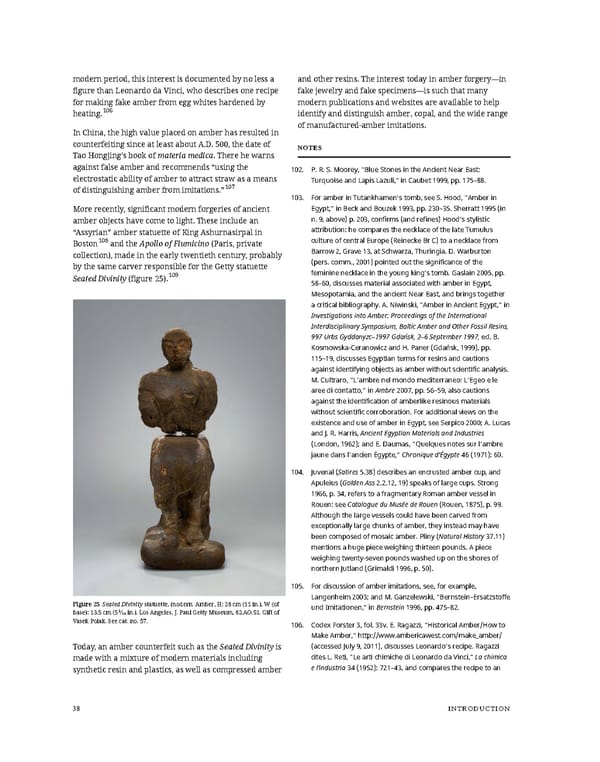modern period, this interest is documented by no less a and other resins. The interest today in amber forgery—in figure than Leonardo da Vinci, who describes one recipe fake jewelry and fake specimens—is such that many for making fake amber from egg whites hardened by modern publications and websites are available to help heating.106 identify and distinguish amber, copal, and the wide range of manufactured-amber imitations. In China, the high value placed on amber has resulted in counterfeiting since at least about A.D. 500, the date of NOTES Tao Hongjing’s book of materia medica. There he warns against false amber and recommends “using the 102. P. R. S. Moorey, “Blue Stones in the Ancient Near East: electrostatic ability of amber to attract straw as a means Turquoise and Lapis Lazuli,” in Caubet 1999, pp. 175–88. of distinguishing amber from imitations.”107 103. For amber in Tutankhamen’s tomb, see S. Hood, “Amber in More recently, significant modern forgeries of ancient Egypt,” in Beck and Bouzek 1993, pp. 230–35. Sherratt 1995 (in amber objects have come to light. These include an n. 9, above) p. 203, confirms (and refines) Hood’s stylistic “Assyrian” amber statuette of King Ashurnasirpal in attribution: he compares the necklace of the late Tumulus Boston108 and the Apollo of Fiumicino (Paris, private culture of central Europe (Reinecke Br C) to a necklace from collection), made in the early twentieth century, probably Barrow 2, Grave 13, at Schwarza, Thuringia. D. Warburton by the same carver responsible for the Getty statuette (pers. comm., 2001) pointed out the significance of the Seated Divinity (figure 25).109 feminine necklace in the young king’s tomb. Gaslain 2005, pp. 58–60, discusses material associated with amber in Egypt, Mesopotamia, and the ancient Near East, and brings together a critical bibliography. A. Niwinski, “Amber in Ancient Egypt,” in Investigations into Amber: Proceedings of the International Interdisciplinary Symposium, Baltic Amber and Other Fossil Resins, 997 Urbs Gyddanyzc–1997 Gdansk, 2–6 September 1997,́ ed. B. Kosmowska-Ceranowicz and H. Paner (Gdańsk, 1999), pp. 115–19, discusses Egyptian terms for resins and cautions against identifying objects as amber without scientific analysis. M. Cultraro, “L’ambre nel mondo mediterraneo: L’Egeo e le aree di contatto,” in Ambre 2007, pp. 56–59, also cautions against the identification of amberlike resinous materials without scientific corroboration. For additional views on the existence and use of amber in Egypt, see Serpico 2000; A. Lucas and J. R. Harris, Ancient Egyptian Materials and Industries (London, 1962); and E. Daumas, “Quelques notes sur l’ambre jaune dans l’ancien Égypte,” Chronique d’Égypte 46 (1971): 60. 104. Juvenal (Satires 5.38) describes an encrusted amber cup, and Apuleius (Golden Ass 2.2.12, 19) speaks of large cups. Strong 1966, p. 34, refers to a fragmentary Roman amber vessel in Rouen: see Catalogue du Musée de Rouen (Rouen, 1875), p. 99. Although the large vessels could have been carved from exceptionally large chunks of amber, they instead may have been composed of mosaic amber. Pliny (Natural History 37.11) mentions a huge piece weighing thirteen pounds. A piece weighing twenty-seven pounds washed up on the shores of northern Jutland (Grimaldi 1996, p. 50). 105. For discussion of amber imitations, see, for example, Langenheim 2003; and M. Ganzelewski, “Bernstein–Ersatzstoffe Figure 25 Seated Divinity statuette, modern. Amber, H: 28 cm (11 in.), W (of und Imitationen,” in Bernstein 1996, pp. 475–82. base): 13.5 cm (53⁄10 in.). Los Angeles, J. Paul Getty Museum, 82.AO.51. Gift of Vasek Polak. See cat. no. 57. 106. Codex Forster 3, fol. 33v. E. Ragazzi, “Historical Amber/How to Make Amber,”http://www.ambericawest.com/make_amber/ Today, an amber counterfeit such as the Seated Divinity is (accessed July 9, 2011), discusses Leonardo’s recipe. Ragazzi made with a mixture of modern materials including cites L. Reti, “Le arti chimiche di Leonardo da Vinci,” La chimica synthetic resin and plastics, as well as compressed amber e l’industria 34 (1952): 721–43, and compares the recipe to an 38 INTRODUCTION
 Ancient Carved Ambers in the J. Paul Getty Museum Page 47 Page 49
Ancient Carved Ambers in the J. Paul Getty Museum Page 47 Page 49